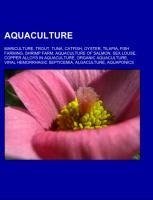
-
 Anglický jazyk
Anglický jazyk
Aquaculture
Autor: Source: Wikipedia
Source: Wikipedia. Pages: 105. Chapters: Mariculture, Trout, Tuna, Catfish, Oyster, Tilapia, Fish farming, Shrimp farm, Aquaculture of salmon, Sea louse, Copper alloys in aquaculture, Organic aquaculture, Viral hemorrhagic septicemia, Algaculture, Aquaponics,... Viac o knihe
Na objednávku, dodanie 2-4 týždne
23.76 €
bežná cena: 26.40 €
O knihe
Source: Wikipedia. Pages: 105. Chapters: Mariculture, Trout, Tuna, Catfish, Oyster, Tilapia, Fish farming, Shrimp farm, Aquaculture of salmon, Sea louse, Copper alloys in aquaculture, Organic aquaculture, Viral hemorrhagic septicemia, Algaculture, Aquaponics, Integrated Multi-Trophic Aquaculture, IMAQUANIM, Scallop aquaculture, Oyster Reef Restoration, Spirulina, Turtle farming, Taura syndrome, Grooved carpet shell, Chlorella, Aquaculture of tilapia, Algae scrubber, Fish meal, Freshwater prawn farm, White spot syndrome, Oyster farming, Infectious salmon anemia virus, Kudoa thyrsites, Commercial fish feed, Genetically modified salmon, Fish hatchery, Tropenhaus Frutigen, Phenoxyethanol, Placopecten magellanicus, Aquaculture of catfish, Veta La Palma, Skretting, Inland saline aquaculture, Gyrodactylus salaris, West Coast of Vancouver Island Aquatic Management Board, Seaweed farming, Oystering machinery, Enteric redmouth disease, AquaBounty technologies, Yellowhead disease, Sergius Orata, Tailwater, European Community Reference Laboratory for Fish Diseases, Huka Prawn Park, List of South American cichlids, Infectious hypodermal and hematopoietic necrosis, Aquaculture engineering, Spawning bed, List of African cichlids, Fishpathogens.eu, Gillardeau oysters, Henneguya zschokkei, Geothermal energy and aquaculture, Hirudiculture, Raceway pond, Best Aquaculture Practices, Broodstock, Accumulated thermal unit, Aquacultureworld, Sailing the Farm. Excerpt: A shrimp farm is an aquaculture business for the cultivation of marine shrimp or prawns for human consumption. Commercial shrimp farming began in the 1970s, and production grew steeply, particularly to match the market demands of the United States, Japan and Western Europe. The total global production of farmed shrimp reached more than 1.6 million tonnes in 2003, representing a value of nearly 9 billion U.S. dollars. About 75% of farmed shrimp is produced in Asia, in particular in China and Thailand. The other 25% is produced mainly in Latin America, where Brazil, Ecuador, and Mexico are the largest producers. The largest exporting nation is Thailand. Shrimp farming has changed from traditional, small-scale businesses in Southeast Asia into a global industry. Technological advances have led to growing shrimp at ever higher densities, and broodstock is shipped worldwide. Virtually all farmed shrimp are of the family Penaeidae, and just two species - Penaeus vannamei (Pacific white shrimp) and Penaeus monodon (giant tiger prawn) - account for roughly 80% of all farmed shrimp. These industrial monocultures are very susceptible to diseases, which have caused several regional wipe-outs of farm shrimp populations. Increasing ecological problems, repeated disease outbreaks, and pressure and criticism from both NGOs and consumer countries led to changes in the industry in the late 1990s and generally stronger regulation by governments. In 1999, a program aimed at developing and promoting more sustainable farming practices was initiated, including governmental bodies, industry representatives, and environmental organizations. Indonesians and others have farmed shrimp for centuries, using traditional low-density methods. Indonesian brackish water ponds, called tambaks, can be traced back as far as the 15th century. They used small scale ponds for monoculture or polycultured with other species, such as milkfish, or in rotation with rice, using the rice paddies for shrimp cultu
- Vydavateľstvo: Books LLC, Reference Series
- Rok vydania: 2021
- Formát: Paperback
- Rozmer: 246 x 189 mm
- Jazyk: Anglický jazyk
- ISBN: 9781155875828

 Nemecký jazyk
Nemecký jazyk 







